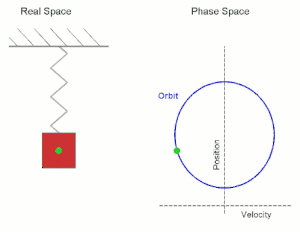Simple Harmonic Motion(SHM) is a type of oscillatory motion. It is where restoring force is directly proportional to the displacement. The motion of a simple pendulum as well as molecular vibration are examples of SHM.
A simple harmonic oscillator is attached to the spring, and the other end of the spring is connected to a rigid support such as a wall. If the system is left at rest at the equilibrium position then there is no net force acting on the mass. However, if the mass is displaced from the equilibrium position,a restoring elastic force which obeys Hooke's law is exerted by the spring.
 where F is the restoring elastic force exerted by the spring (in SI units: N), k is the spring constant (N·m−1), and x is the displacement from the equilibrium position (in m).
where F is the restoring elastic force exerted by the spring (in SI units: N), k is the spring constant (N·m−1), and x is the displacement from the equilibrium position (in m).
From the above equation F = -k.x where k is the spring constant and the -ve sign is to show that the Force is towards the equilibrium.
Velocity is maximum at equilibrium position. Displacement and acceleration are maximum at the maximum amplitude though they are independent of amplitude.

In the small-angle approximation, the motion of a simple pendulum is approximated by simple harmonic motion. The period of a mass attached to a string of length ℓ with gravitational acceleration g is given by
 |
| Simple Pendulum executing SHM |
Mathematically, the restoring force F is given by
 where F is the restoring elastic force exerted by the spring (in SI units: N), k is the spring constant (N·m−1), and x is the displacement from the equilibrium position (in m).
where F is the restoring elastic force exerted by the spring (in SI units: N), k is the spring constant (N·m−1), and x is the displacement from the equilibrium position (in m).
For any simple harmonic oscillator:
- When the system is displaced from its equilibrium position, a restoring force which resembles Hooke's law tends to restore the system to equilibrium.
Once the mass is displaced from its equilibrium position, it experiences a net restoring force. As a result, it accelerates and starts going back to the equilibrium position. When the mass moves closer to the equilibrium position, the restoring force decreases. At the equilibrium position, the net restoring force vanishes. However, at x = 0, the mass has momentum because of the impulse that the restoring force has imparted. Therefore, the mass continues past the equilibrium position, compressing the spring. A net restoring force then tends to slow it down, until its velocity vanishes, whereby it will attempt to reach equilibrium position again.
As long as the system has no energy loss, the mass will continue to oscillate. Thus, simple harmonic motion is a type of periodic motion.
Formulae:
From the above equation F = -k.x where k is the spring constant and the -ve sign is to show that the Force is towards the equilibrium.
F = -k.x
F = ma
==> m.a = -k.x
==> m.a + k.x = 0
==> a + (k/m).x = 0
but k/m = w²
Therefore
where ω is the angular frequency
therefore ω = 2πf
Acceleration as a function of displacement:
and
 |
Velocity is maximum at equilibrium position. Displacement and acceleration are maximum at the maximum amplitude though they are independent of amplitude.
Mass on a spring
A mass m attached to a spring of spring constant k exhibits simple harmonic motion in space. The equation
shows that the period of oscillation is independent of both the amplitude and gravitational acceleration
Uniform circular motion
Simple harmonic motion can in some cases be considered to be the one-dimensional projection of uniform circular motion. If an object moves with angular velocity ω around a circle of radius r centered at the origin of the x-y plane, then its motion along each coordinate is simple harmonic motion with amplitude r and angular frequency ω.
Mass on a simple pendulum

In the small-angle approximation, the motion of a simple pendulum is approximated by simple harmonic motion. The period of a mass attached to a string of length ℓ with gravitational acceleration g is given by
This shows that the period of oscillation is independent of the amplitude and mass of the pendulum but not the acceleration due to gravity (g), therefore a pendulum of the same length on the Moon would swing more slowly due to the Moon's lower gravitational acceleration.















0 comments:
Post a Comment